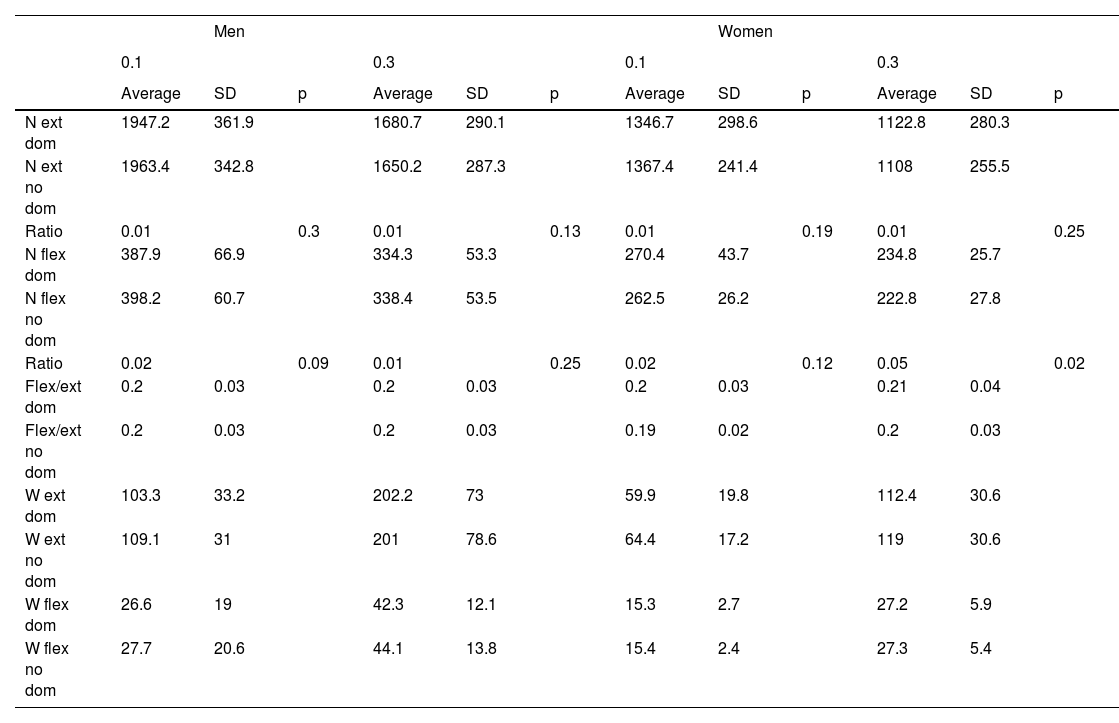To describe the values of isokinetic strength in closed kinetic chain (CKC) in young adults and their reproducibility.
MethodsTest and re-test in isokinetic leg press, unilateral mode at 0.1 m/s and 0.3 m/s, 2 sets of 10 repetitions at each speed was performed.
Results30 men and 22 women were included. The isokinetic values show differences between men and women. The intraclass correlation coefficient was >0.88 (p < 0.001) except in flexors (women), 0.74.
ConclusionThe CKC isokinetic test is valid, reproducible, and safe.
Isokinetics can be defined as a robotic system to evaluate qualitative and quantitative data on muscular effort.1 It is composed of a constant speed and a variable resistance throughout the range of motion.2 The closed kinetic chain (CKC) has been described as “functional” as it is useful in tasks such as standing, sitting, using a ladder, etc.3 Dvir2 mentions that the CKC requires multi-joint effort, involves less anterior translation of the tibia and less stress on the anterior cruciate ligament. Davies4 adds that the CKC can mask certain localized deficiencies because it compensates with the effort of the other joints.
The CKC is important for movements such as squatting, lunging, jumping, and running, so it must be studied, and analyzed and establish balances that translate for specific tasks.3 We present a cross-sectional study with the aim of describing the values of isokinetic strength in CKC in young adults, the balance between both sides, the flexor/extensor ratio, and their reproducibility.
MethodsYoung adults of both genders, without lower limbs or chronic known pathology, were included; a clinical history was taken to determine the absence of existing or recent joint disease and cardiovascular risk, and informed consent was signed.
Leg Press test was carried out with a Con-Trex LP isokinetic dynamometer, with the following parameters:
Seat inclination 80°, knee extension −20°, hip and knee flexion 90°. Test and re-test in unilateral mode at 0.1 m/s and 0.3 m/s, 2 sets of 10 repetitions at each speed. Warming up and cooling down was performed with continuous passive movement. The values of force were obtained in Newtons (N), muscle power output in Watt (W), differences between both sides, and flexor/extensor ratio.
Data analysis was performed using SPSS software version 24.0; The difference between both sides was analyzed with paired t and reproducibility with intraclass correlation coefficient.
Results52 people were included, 30 men (average age 30.8 ± 5.3 years, 76.8 ± 10.5 kg weight, 1.72 ± 0.65 m height) and 22 women (average age 29 ± 4.1 years, 59.4 ± 9.6 kg weight, 1.61 ± 0.55 height), who were analyzed separately.
The isokinetic values show a difference of almost 600 N between men and women at 0.1 m/s and 500 N at 0.3 for the extensor chain, with differences between right and left sides of 1 % in all cases; and a difference of almost 100 N in the flexors. The flexor/extensor ratio was 20 % at both speeds and sexes. These values are shown in Table 1.
Isokinetic values in both groups.
SD, standard desviation; N, Newton; Ext, extensors; Flex, flexors; dom: dominant side; No dom, non dominant side; W, Watt.
Reproducibility was determined with the results of the test and re-test. The intraclass correlation coefficient (ICC) was high for the extensor chains at both speeds and good for the flexors in women (Table 2).
Intraclass correlation in isokinetic tests.
N, Newton; Ext, extensors; Flex, flexors.
To our knowledge, this is the first research to describe values in young adults with a linear isokinetic dynamometer. Loeza3 used an angular dynamometer, with positioning adapted to CKC, so the values obtained are in degrees per second and not meters per second. Liebensteiner5 described values in men and women, however, these were at 0.2 m/s and in eccentric movement, so we have no point of comparison. They found that there were no significant differences in the evaluation between men and women in strength, electromyographic muscle activity, and leg kinematics; in our study, we found a significant difference in both sexes, at both speeds.
Dvir and Müller6 describe that in the isokinetic test in CKC, the fixation points are in the hip and foot, but with instability in the knee, however, the forces of the three joints are added to result in a linear vector. In our study, the values obtained have no comparison with those described in a similar population, as it is a physical magnitude different from the angular dynamometry. We can also highlight that the ratio flexor/extensor differs from that obtained with an open chain. Loeza7 describes a series of values obtained in different papers, which are 0.55, unlike what was mentioned by Dvir (0.6)2; in our results, we found a ratio of 0.2 for both groups, at both speeds. This is similar to that described by Loeza3 in young athletes, in the previously mentioned situation of CKC adaptation with an angular dynamometer. This can be understood because the flexor chain (in CKC) does not require the level of force that the extensor chain (antigravity) does.
Reproducibility was high in both groups and at both speeds, since it is not operator-dependent, but rather an exact measurement; similar to that described by other authors regarding the validity of isokinetics. No adverse events occurred during the evaluations.
Our results suggest that the CKC isokinetic test is valid, reproducible, different from another physical evaluation with an angular dynamometer, and safe; and the motor gesture resembles activities of daily life such as walking or climbing stairs; making it an alternative to other strength assessments.
There are no conflicts of interest to declare.
Abbreviations: CKC, closed kinetic chain








